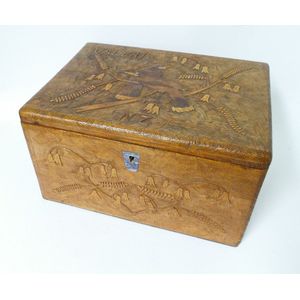Brass Inlaid Rosewood Writing Box - Damaged
You must be a subscriber, and be logged in to view price and dealer details.
Subscribe Now to view actual auction price for this item
When you subscribe, you have the option of setting the currency in which to display prices to $Au, $US, $NZ or Stg.
- Rosewood - A dense timber that varies in shade to very light brown to almost black. When rosewood is cut and sanded the colour of the timber will turn black, and after polishing and exposure to daylight, the surface will gradually lighten over time to light brown with black streaks.
The name comes from the odour emanating from the timber when it is planed, sanded or cut.
Rosewood was very popular for use in Victorian furniture in the second half of the 19th century, and at that time most of the rosewood was imported from Brazil. However it also grows in India and Indonesia.
It is used in the sold for chairs and table legs, but for carcase furniture such as side cabinets and bookcases, and for table tops it is always used as a veneer. - A/f, as Inspected - The letters "A/F" or "as inspected" as part of a description is the cataloguer's shorthand for "all faults" or "as found", meaning the item has some type of damage or deficiency, it is of uncertain date or provenance, and/or that the seller takes no responsibility for the completeness of the item or the accuracy of the description.
- Regency Period - The Regency period in English furniture design refers to the period when King George III, was declared unfit to rule in 1811, and his son ruled as proxy as Prince Regent, until 1820, and then, after the death of his father as George IV until his death in 1830. The Regency period was preceded by the Georgian period (George I, George II, and George III: 1714 - 1811), and was followed by the William IV period, which only lasted until 1837 when William IV died as was succeeded by Queen Victoria.
This item has been included into following indexes:
Visually similar items

An intriguing Anglo-Indian timber and brass jewellery box, late 19th century, with an arabesque decorated lid, brass edges and recessed bracket handles, the fine interior fitted with a series of drawers, removable trays, boxes, some inlaid, and fold out co

A Regency period, rosewood and brass inlay sarcophagus shape, tea caddy, c.1820-1830, with two pullout canister boxes and central cut crystal mixing bowl. Height 19.2 cm. Length 30 cm. Depth 16 cm

A New Zealand timber folk art jewellery box, carved in low relief to the lid and walls with huia birds and kowhai, named 'Valerie' to the lid, the interior with blue velvet lining and removable tray. 30 cm x 22 cm x 17 cm

Edwardian inlayed wooden musical jewellery box and cover, of square form, decorated with floral scroll work, length 17 cm
